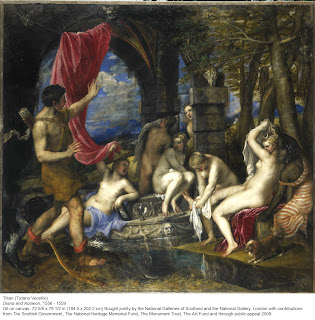Talk Given By Mr. Graham Giles
Mr. Graham Giles guided a talk about one of the most important paintings of the Italian Renaissance. Believed to be one of the artist's greatest creations, this became apparent upon immediate reaction to first seeing the work. Its sheer scale presented immense volume in captivating audience attention. The lavish gold frame, which encased the work, certainly aided in embellishing on such visual entrapment. The unity in colour and light and shadow contrast, assisted in the flow of the narration. After reading the poem, Metamorphoses by Ovid, which the painting is based on, it becomes clear why Titian needed to express such a rich piece of literature in a most lavish manner.
Giles pointed out at the end of the talk that an hour spent speaking about and interpreting this piece of art is necessary and he and Mr. Simon Granger, encouraged greater visual examination of the piece. When studying the piece your eye flows throughout the story, investigating the characters and then their surroundings. You then begin to pick up on certain details such as the opposition in size and attitude in the dogs. This particular detail, produces a humouristic element into the story. As well as the detail of the sinking platform which appears to be gushing water under the weight of the nymph.
Its interesting to see the clear past, present and future developments of the poems tale, in the painting. We see the hunter has his bow and arrows and his hound dog, revealing act of past hunting. Acteon is in movement, representing the chance encounter with the goddess, the present and main point of view of the painting. We then can see a Stag skull placed above the bathing nymphs on a column in the background, with what appears to be, pieces of pelt. This signifies the hunters impending doom because of his discovery. The clearly lit, blue sky is quite juxtaposed to the mood of the tale. However, Giles pointed out that the cleaning of such paintings creates difference in colour and tonal range of the original work.
In terms of anatomy, I found myself completely enthralled with Acteon's anatomical correctness and the level of rendering achieved. This, for me, juxtaposed Diana, whose neck and head are oddly placed, directing your eye to her and aiding in making her the focal point of the painting. It was pointed out, at the talk, that this was perhaps intentional as opposed to an error. However, it was also pointed out that the piece would have been worked on by other painters who may have attributed to Diana specifically. Another aspect of the work that guides the eye to Diana is the placement of a dark-skinned woman beside Diana. This difference in light and dark, enhances Diana's presence. Mr. Simon Granger pointed out, that the X-rays of the piece revealed the dark-skinned female may have been originally planned to be a white female. This possible change in direction, suggests that Titian's (and artists' in general) thought process(es) occur(s) continuously through production and not just in the pre-production planning of the work. I find this quite interesting, as it assumed that perfect planning is a natural and necessary incorporation into 'perfect' art and yet it is in the correction and development of ideas, where the perfection lies.
Titian, Diana and Actaeon 1556-1559

No comments:
Post a Comment